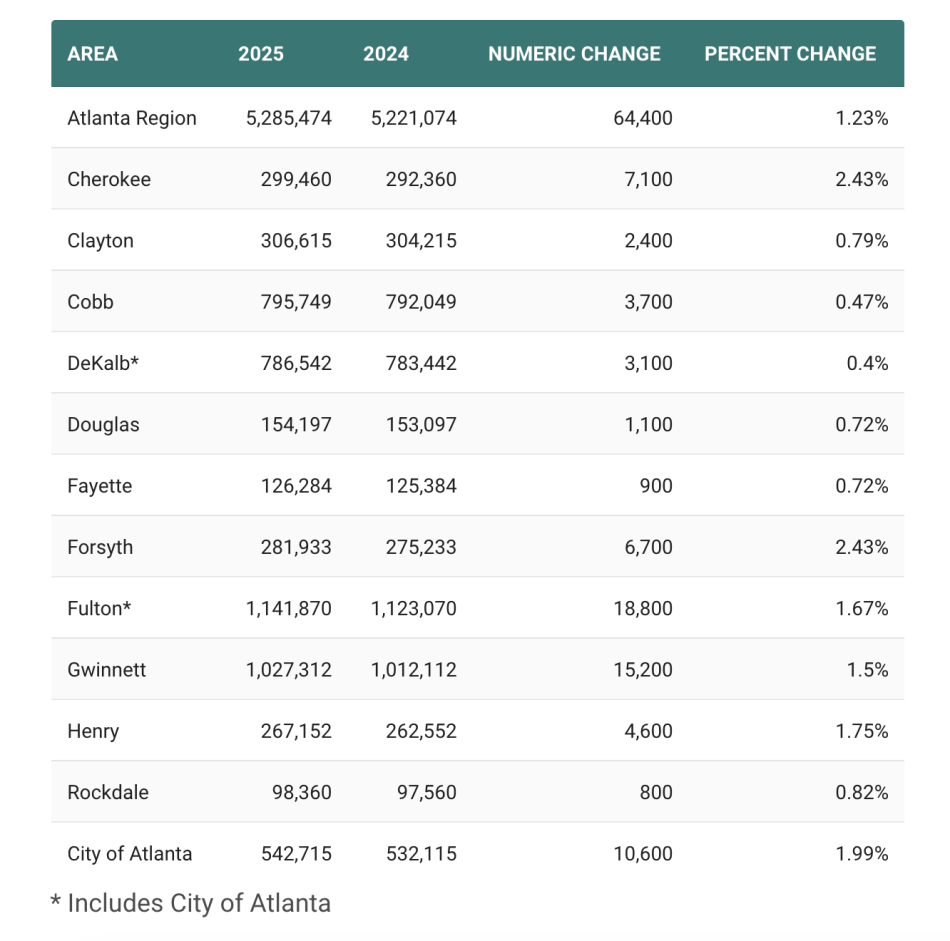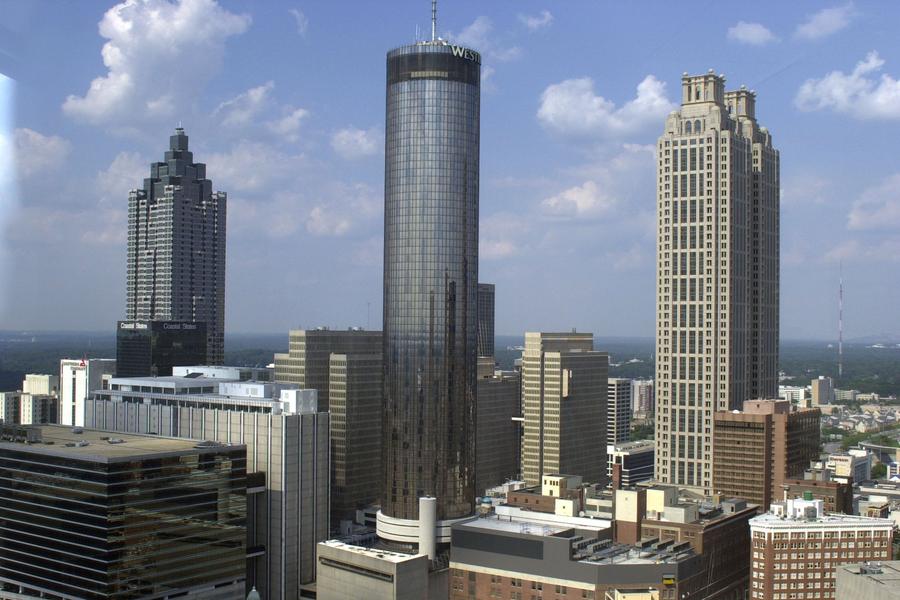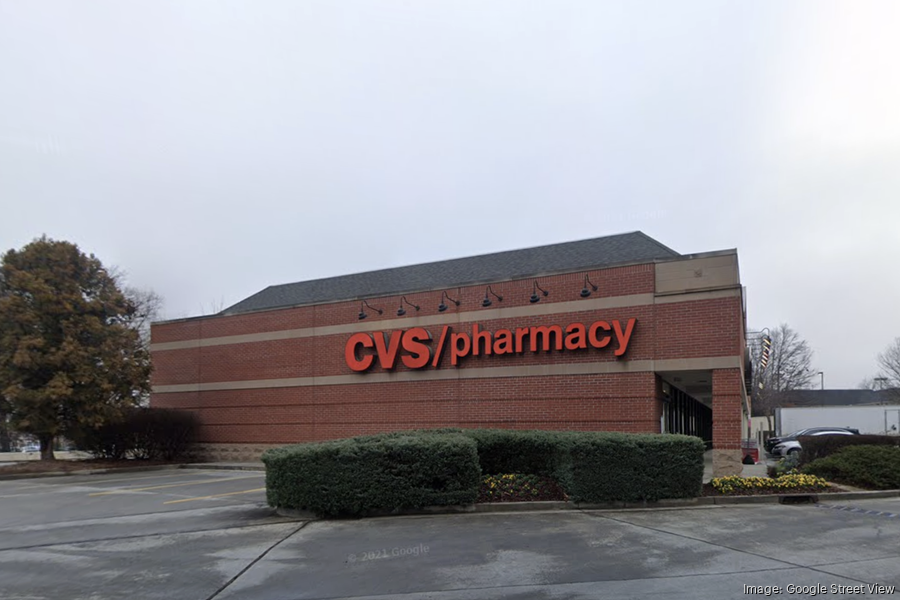Official: $30M project linking downtown, Beltline safe from budget cuts
Official: $30M project linking downtown, Beltline safe from budget cuts
Official: $30M project linking downtown, Beltline safe from budget cuts
Josh Green
Thu, 08/14/2025 – 08:42
A recent spate of federal funding retractions won’t impact a project geared toward making Atlanta streets safer and fast-tracking multimodal access between downtown and the Beltline, officials tell Urbanize Atlanta.
Promising local impacts in cities and rural communities across the country, grants from the federal program Safe Streets and Roads for All, or SS4A, were announced in February 2023.
The City of Atlanta came out a big winner with a $30-million max grant that calls for transforming two streets—Pryor Street and Central Avenue—to act as safer connections between downtown and the Beltline’s Southside Trail corridor.
Two and ½ years later, construction has yet to begin, but an Atlanta Department of Transportation spokesperson says preliminary work is underway. “At this time,” the official noted in an email, “the [city] is not aware of any changes to or reallocation of the $30 million in awarded funds.”
Since the grant was announced, ATLDOT has finalized an agreement with the Federal Highway Administration for the SS4A and Pryor Safe Streets project. Under that agreement, work is expected to move forward in three phases, as outlined this week by ATLDOT:
- Base Phase: This includes preliminary design and National Environmental Policy Act work, costing $2.4 million in federal funds;
- Option Phase 1: Final design, right-of-way acquisition, and utility work, totaling $9.8 million in federal funds;
- Option Phase 2: Construction, supported by $17.7 million in federal funding.
ATLDOT is currently in the base phase, with design procurement underway. Going forward, each phase will be contingent on meeting specific conditions—primarily related to the environmental act—before work can proceed to the next funding stage. “Our grant’s period of performance runs through January 31, 2029,” wrote the ATLDOT spokesperson, “and we are on track with the established project schedule.”
ATLDOT expects the full project design to be finished by September next year, as outlined in an FHWA agreement. Construction would follow that.
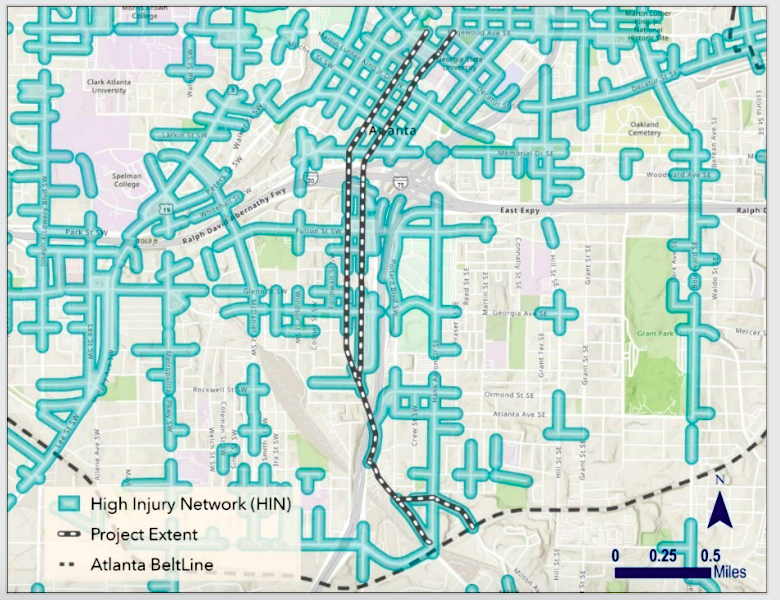
Planned Complete Streets route from the BeltLine’s Southside Trail near Hank Aaron Drive up to the heart of downtown. Safe Streets and Roads for All Grant Program
According to project plans released in 2023, protected bike and pedestrian facilities would be added where there is currently no north-south connection between downtown and the Beltline’s Southside Trail. The area is riddled with crash hotspots on Atlanta’s high-injury network.
Heading south, the safety improvements would start near Woodruff Park and Georgia State University, cross over Memorial Drive, and duck under interstates before meeting the Beltline at Milton Avenue—where a groundswell of residential development has taken shape in recent years and food-and-beverage hub Terminal South is nearing its debut.
That’s a distance of just under three miles.
Safety upgrades along that route call for bike lanes, crosswalk lighting, roadway reconfigurations, medians, safer speed limits, and rectangular rapid-flashing beacons, among other changes.
Atlanta’s $30-million award marked the largest amount allotted to any project in the country—alongside a vision-zero safety plan in Philadelphia—in its round of 2023 grants.
The U.S. Transportation Department’s summation called the Atlanta project “a major expansion of the current system and bike network” that will boost safety and “promote mode shift from single-occupancy vehicles to more active transportation modes.”
The competitive grant program, as established by President Joe Biden’s infrastructure law, was expected to provide $5 billion over five years for regional, local, and Tribal initiatives, ranging from better sidewalks and crosswalks to redesigned roads. The broad goal was to help quell injuries and deaths on America’s streets and roadways, federal officials said.
The ATLDOT update follows recent news that downtown’s highway-capping Stitch project is losing the bulk of its funding—more than $150 million in federal cash previously approved by Biden’s administration—that was required to complete phase one.
Stitch leadership has recently said the project will continue to move forward and seek alternate funding sources.
…
Follow us on social media:
Twitter / Facebook/and now: Instagram
• Downtown news, discussion (Urbanize Atlanta)

Official: $30M project linking downtown, Beltline safe from budget cuts
Josh Green
Thu, 08/14/2025 – 08:42
A recent spate of federal funding retractions won’t impact a project geared toward making Atlanta streets safer and fast-tracking multimodal access between downtown and the Beltline, officials tell Urbanize Atlanta. Promising local impacts in cities and rural communities across the country, grants from the federal program Safe Streets and Roads for All, or SS4A, were announced in February 2023. The City of Atlanta came out a big winner with a $30-million max grant that calls for transforming two streets—Pryor Street and Central Avenue—to act as safer connections between downtown and the Beltline’s Southside Trail corridor. Two and ½ years later, construction has yet to begin, but an Atlanta Department of Transportation spokesperson says preliminary work is underway. “At this time,” the official noted in an email, “the [city] is not aware of any changes to or reallocation of the $30 million in awarded funds.”Since the grant was announced, ATLDOT has finalized an agreement with the Federal Highway Administration for the SS4A and Pryor Safe Streets project. Under that agreement, work is expected to move forward in three phases, as outlined this week by ATLDOT: Base Phase: This includes preliminary design and National Environmental Policy Act work, costing $2.4 million in federal funds;Option Phase 1: Final design, right-of-way acquisition, and utility work, totaling $9.8 million in federal funds;Option Phase 2: Construction, supported by $17.7 million in federal funding.ATLDOT is currently in the base phase, with design procurement underway. Going forward, each phase will be contingent on meeting specific conditions—primarily related to the environmental act—before work can proceed to the next funding stage. “Our grant’s period of performance runs through January 31, 2029,” wrote the ATLDOT spokesperson, “and we are on track with the established project schedule.” ATLDOT expects the full project design to be finished by September next year, as outlined in an FHWA agreement. Construction would follow that.
Planned Complete Streets route from the BeltLine’s Southside Trail near Hank Aaron Drive up to the heart of downtown. Safe Streets and Roads for All Grant Program
According to project plans released in 2023, protected bike and pedestrian facilities would be added where there is currently no north-south connection between downtown and the Beltline’s Southside Trail. The area is riddled with crash hotspots on Atlanta’s high-injury network.Heading south, the safety improvements would start near Woodruff Park and Georgia State University, cross over Memorial Drive, and duck under interstates before meeting the Beltline at Milton Avenue—where a groundswell of residential development has taken shape in recent years and food-and-beverage hub Terminal South is nearing its debut. That’s a distance of just under three miles.Safety upgrades along that route call for bike lanes, crosswalk lighting, roadway reconfigurations, medians, safer speed limits, and rectangular rapid-flashing beacons, among other changes.Atlanta’s $30-million award marked the largest amount allotted to any project in the country—alongside a vision-zero safety plan in Philadelphia—in its round of 2023 grants.The U.S. Transportation Department’s summation called the Atlanta project “a major expansion of the current system and bike network” that will boost safety and “promote mode shift from single-occupancy vehicles to more active transportation modes.”The competitive grant program, as established by President Joe Biden’s infrastructure law, was expected to provide $5 billion over five years for regional, local, and Tribal initiatives, ranging from better sidewalks and crosswalks to redesigned roads. The broad goal was to help quell injuries and deaths on America’s streets and roadways, federal officials said.The ATLDOT update follows recent news that downtown’s highway-capping Stitch project is losing the bulk of its funding—more than $150 million in federal cash previously approved by Biden’s administration—that was required to complete phase one. Stitch leadership has recently said the project will continue to move forward and seek alternate funding sources….Follow us on social media: Twitter / Facebook/and now: Instagram • Downtown news, discussion (Urbanize Atlanta)
Tags
Pryor Street
Central Avenue
2022 Safe Streets for All Implementation Grant
Southside Trail
Beltline
Atlanta BeltLine
Complete Streets
U.S. Secretary of Transportation Pete Buttigieg
U.S. Department of Transportation
ATLDOT
Atlanta Department of Transportation
Alternate Transportation
Alternative Transportation
Images
Planned Complete Streets route from the BeltLine’s Southside Trail near Hank Aaron Drive up to the heart of downtown. Safe Streets and Roads for All Grant Program
Subtitle
Where work stands today, following major federal Safe Streets grant in 2023
Neighborhood
Citywide
Background Image
Image
Before/After Images
Sponsored Post
Off Read More
Official: $30M project linking downtown, Beltline safe from budget cuts
Josh Green
Thu, 08/14/2025 – 08:42
A recent spate of federal funding retractions won’t impact a project geared toward making Atlanta streets safer and fast-tracking multimodal access between downtown and the Beltline, officials tell Urbanize Atlanta. Promising local impacts in cities and rural communities across the country, grants from the federal program Safe Streets and Roads for All, or SS4A, were announced in February 2023. The City of Atlanta came out a big winner with a $30-million max grant that calls for transforming two streets—Pryor Street and Central Avenue—to act as safer connections between downtown and the Beltline’s Southside Trail corridor. Two and ½ years later, construction has yet to begin, but an Atlanta Department of Transportation spokesperson says preliminary work is underway. “At this time,” the official noted in an email, “the [city] is not aware of any changes to or reallocation of the $30 million in awarded funds.”Since the grant was announced, ATLDOT has finalized an agreement with the Federal Highway Administration for the SS4A and Pryor Safe Streets project. Under that agreement, work is expected to move forward in three phases, as outlined this week by ATLDOT: Base Phase: This includes preliminary design and National Environmental Policy Act work, costing $2.4 million in federal funds;Option Phase 1: Final design, right-of-way acquisition, and utility work, totaling $9.8 million in federal funds;Option Phase 2: Construction, supported by $17.7 million in federal funding.ATLDOT is currently in the base phase, with design procurement underway. Going forward, each phase will be contingent on meeting specific conditions—primarily related to the environmental act—before work can proceed to the next funding stage. “Our grant’s period of performance runs through January 31, 2029,” wrote the ATLDOT spokesperson, “and we are on track with the established project schedule.” ATLDOT expects the full project design to be finished by September next year, as outlined in an FHWA agreement. Construction would follow that.
Planned Complete Streets route from the BeltLine’s Southside Trail near Hank Aaron Drive up to the heart of downtown. Safe Streets and Roads for All Grant Program
According to project plans released in 2023, protected bike and pedestrian facilities would be added where there is currently no north-south connection between downtown and the Beltline’s Southside Trail. The area is riddled with crash hotspots on Atlanta’s high-injury network.Heading south, the safety improvements would start near Woodruff Park and Georgia State University, cross over Memorial Drive, and duck under interstates before meeting the Beltline at Milton Avenue—where a groundswell of residential development has taken shape in recent years and food-and-beverage hub Terminal South is nearing its debut. That’s a distance of just under three miles.Safety upgrades along that route call for bike lanes, crosswalk lighting, roadway reconfigurations, medians, safer speed limits, and rectangular rapid-flashing beacons, among other changes.Atlanta’s $30-million award marked the largest amount allotted to any project in the country—alongside a vision-zero safety plan in Philadelphia—in its round of 2023 grants.The U.S. Transportation Department’s summation called the Atlanta project “a major expansion of the current system and bike network” that will boost safety and “promote mode shift from single-occupancy vehicles to more active transportation modes.”The competitive grant program, as established by President Joe Biden’s infrastructure law, was expected to provide $5 billion over five years for regional, local, and Tribal initiatives, ranging from better sidewalks and crosswalks to redesigned roads. The broad goal was to help quell injuries and deaths on America’s streets and roadways, federal officials said.The ATLDOT update follows recent news that downtown’s highway-capping Stitch project is losing the bulk of its funding—more than $150 million in federal cash previously approved by Biden’s administration—that was required to complete phase one. Stitch leadership has recently said the project will continue to move forward and seek alternate funding sources….Follow us on social media: Twitter / Facebook/and now: Instagram • Downtown news, discussion (Urbanize Atlanta)
Tags
Pryor Street
Central Avenue
2022 Safe Streets for All Implementation Grant
Southside Trail
Beltline
Atlanta BeltLine
Complete Streets
U.S. Secretary of Transportation Pete Buttigieg
U.S. Department of Transportation
ATLDOT
Atlanta Department of Transportation
Alternate Transportation
Alternative Transportation
Images
Planned Complete Streets route from the BeltLine’s Southside Trail near Hank Aaron Drive up to the heart of downtown. Safe Streets and Roads for All Grant Program
Subtitle
Where work stands today, following major federal Safe Streets grant in 2023
Neighborhood
Citywide
Background Image
Image
Before/After Images
Sponsored Post
Off
Georgia’s life sciences sector has grown, but key ingredients still lacking
Georgia’s life sciences sector has grown, but key ingredients still lacking
Georgia’s life sciences industry is the third-largest among Southeastern states based on the number of companies and economic impact, but it is in danger of letting rivals gain ground, observers warn.
Georgia’s life sciences industry is the third-largest among Southeastern states based on the number of companies and economic impact, but it is in danger of letting rivals gain ground, observers warn. Read MoreBizjournals.com Feed (2019-09-06 17:16:48)
Georgia’s life sciences industry is the third-largest among Southeastern states based on the number of companies and economic impact, but it is in danger of letting rivals gain ground, observers warn.
Georgia’s life sciences sector has grown, but key ingredients still lacking
Georgia’s life sciences sector has grown, but key ingredients still lacking
Georgia’s life sciences industry is the third-largest among Southeastern states based on the number of companies and economic impact, but it is in danger of letting rivals gain ground, observers warn.
Georgia’s life sciences industry is the third-largest among Southeastern states based on the number of companies and economic impact, but it is in danger of letting rivals gain ground, observers warn. Read MoreBizjournals.com Feed (2022-04-02 21:43:57)
Georgia’s life sciences industry is the third-largest among Southeastern states based on the number of companies and economic impact, but it is in danger of letting rivals gain ground, observers warn.
ARC: Metro Atlanta packed on nearly 65K more people in past year
ARC: Metro Atlanta packed on nearly 65K more people in past year
ARC: Metro Atlanta packed on nearly 65K more people in past year
Josh Green
Wed, 08/13/2025 – 17:01
Metro Atlanta’s decades-long growth spurt is hardly petering out, and the strongest growth patterns are now concentrated in the City of Atlanta itself and outer suburbs, according to new Atlanta Regional Commission data compiled in a closely watched annual report.
According to ARC estimates, Atlanta’s 11-county metropolitan area added 64,400 residents over the year prior to April, for a total population of 5.28 million. All 11 counties studied experienced population gains in that time period, per ARC officials. (Note: The U.S. Census Bureau defines metro Atlanta as 29 counties with a population of roughly a million more people.)
The ARC’s findings come after a Wall Street Journal report titled “Atlanta’s Growth Streak Has Come to an End” caused a national stir last month, pointing to a dip in domestic migration over the 12 months ending in mid-2024. Atlanta boosters and economists argued that take didn’t paint the full picture of metro population trends.
The metro’s growth is actually gaining momentum, if slightly. The nearly 65,000 people added metro-wide last year was about 1,700 more than the year prior, per the ARC’s analysis, though growth rates remain significantly lower than boomtimes in the 1980s and 1990s.
As with previous years, the City of Atlanta led the region in number of building permits issued (8,109) by far; second-place Gwinnett County notched 5,607 permits in the same period.
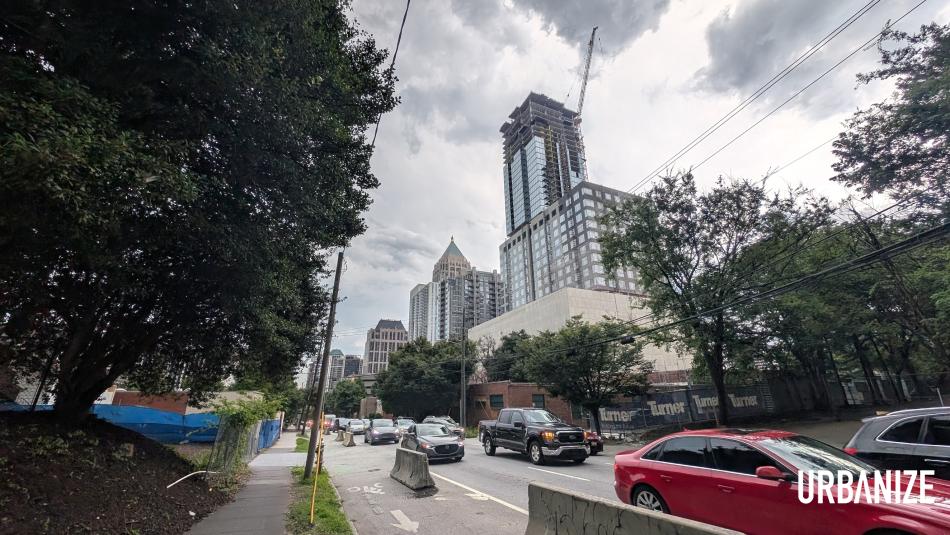
Looking northeast, the 1072 West Peachtree skyrise’s stance over Spring Street, with other landmark Midtown buildings in the background. Josh Green/Urbanize Atlanta
According to ARC estimates, the city added another 10,600 people for nearly 2 percent growth. That pushed the city’s total population to almost 543,000 residents—good for the most in history, following a previous peak of 497,000 residents in the 1970s.
Multifamily housing developments in hot zones such as Midtown and along the Beltline corridor have fueled the city’s population surge, which has averaged 1.7 percent since 2010, following three decades of stagnation, per the ARC.
The only higher metro growth rates across the year ending in April were logged in Forsyth and Cherokee counties, which each swelled at a 2.4-percent clip, per the ARC.
Fulton County—including the City of Atlanta—tallied the highest numeric boost in residents in the region (18,800), followed by Gwinnett (15,200), Cherokee (7,100), Forsyth (6,700), and Henry (4,600) counties. (Strangely absent: Cobb and DeKalb, eh?)
Driving the metro’s growth is an employment base that’s swelled by 8 percent since pandemic-addled early 2020, good for the seventh-highest rate in the nation among metro areas, per ARC’s tally. But the outlook isn’t entirely rosy. Spiking housing costs, driven by still-low supply, have “acted as a brake on the region’s population growth,” per the report.
Throughout 2024, just shy of 29,500 building permits were issue across the 11-county region. That’s a 3-percent increase from a year earlier, but it’s still lower than permit levels prior to the Great Recession, when the metro’s population was smaller, per the ARC.
Anna Roach, ARC executive director and CEO, said the new data show metro Atlanta continues to be among the country’s most dynamic and vibrant regions. “Businesses continue to choose metro Atlanta as a place to grow and thrive, from global corporations to nimble start-ups,” said Roach in a statement. “This keeps our economy moving and our population growing.”
…
Follow us on social media:
Twitter / Facebook/and now: Instagram
• Is Atlanta’s hot streak ending—or are red flags overblown? (Urbanize Atlanta)
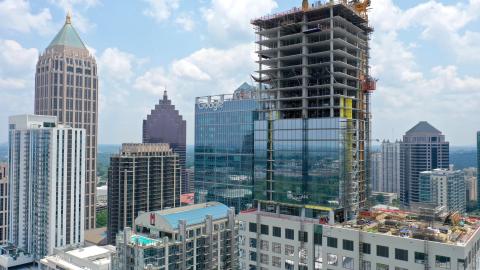
ARC: Metro Atlanta packed on nearly 65K more people in past year
Josh Green
Wed, 08/13/2025 – 17:01
Metro Atlanta’s decades-long growth spurt is hardly petering out, and the strongest growth patterns are now concentrated in the City of Atlanta itself and outer suburbs, according to new Atlanta Regional Commission data compiled in a closely watched annual report. According to ARC estimates, Atlanta’s 11-county metropolitan area added 64,400 residents over the year prior to April, for a total population of 5.28 million. All 11 counties studied experienced population gains in that time period, per ARC officials. (Note: The U.S. Census Bureau defines metro Atlanta as 29 counties with a population of roughly a million more people.)The ARC’s findings come after a Wall Street Journal report titled “Atlanta’s Growth Streak Has Come to an End” caused a national stir last month, pointing to a dip in domestic migration over the 12 months ending in mid-2024. Atlanta boosters and economists argued that take didn’t paint the full picture of metro population trends. The metro’s growth is actually gaining momentum, if slightly. The nearly 65,000 people added metro-wide last year was about 1,700 more than the year prior, per the ARC’s analysis, though growth rates remain significantly lower than boomtimes in the 1980s and 1990s. As with previous years, the City of Atlanta led the region in number of building permits issued (8,109) by far; second-place Gwinnett County notched 5,607 permits in the same period.
Looking northeast, the 1072 West Peachtree skyrise’s stance over Spring Street, with other landmark Midtown buildings in the background. Josh Green/Urbanize Atlanta
According to ARC estimates, the city added another 10,600 people for nearly 2 percent growth. That pushed the city’s total population to almost 543,000 residents—good for the most in history, following a previous peak of 497,000 residents in the 1970s. Multifamily housing developments in hot zones such as Midtown and along the Beltline corridor have fueled the city’s population surge, which has averaged 1.7 percent since 2010, following three decades of stagnation, per the ARC. The only higher metro growth rates across the year ending in April were logged in Forsyth and Cherokee counties, which each swelled at a 2.4-percent clip, per the ARC. Fulton County—including the City of Atlanta—tallied the highest numeric boost in residents in the region (18,800), followed by Gwinnett (15,200), Cherokee (7,100), Forsyth (6,700), and Henry (4,600) counties. (Strangely absent: Cobb and DeKalb, eh?) Driving the metro’s growth is an employment base that’s swelled by 8 percent since pandemic-addled early 2020, good for the seventh-highest rate in the nation among metro areas, per ARC’s tally. But the outlook isn’t entirely rosy. Spiking housing costs, driven by still-low supply, have “acted as a brake on the region’s population growth,” per the report. Throughout 2024, just shy of 29,500 building permits were issue across the 11-county region. That’s a 3-percent increase from a year earlier, but it’s still lower than permit levels prior to the Great Recession, when the metro’s population was smaller, per the ARC. Anna Roach, ARC executive director and CEO, said the new data show metro Atlanta continues to be among the country’s most dynamic and vibrant regions. “Businesses continue to choose metro Atlanta as a place to grow and thrive, from global corporations to nimble start-ups,” said Roach in a statement. “This keeps our economy moving and our population growing.”
Atlanta Regional Commission
…Follow us on social media: Twitter / Facebook/and now: Instagram • Is Atlanta’s hot streak ending—or are red flags overblown? (Urbanize Atlanta)
Tags
Atlanta Population
Atlanta Population Growth
City of Atlanta Population
Atlanta Population Decline
Atlanta Decline
Wall Street Journal
Atlanta Growth
Atlanta Development
Cotality
Homes.com
U.S. Census
Atlanta Housing Market
Atlanta Regional Commission
ARC
Images
Atlanta Regional Commission
Subtitle
So reports of our demise were greatly exaggerated?
Neighborhood
Citywide
Background Image
Image
Before/After Images
Sponsored Post
Off Read More
ARC: Metro Atlanta packed on nearly 65K more people in past year
Josh Green
Wed, 08/13/2025 – 17:01
Metro Atlanta’s decades-long growth spurt is hardly petering out, and the strongest growth patterns are now concentrated in the City of Atlanta itself and outer suburbs, according to new Atlanta Regional Commission data compiled in a closely watched annual report. According to ARC estimates, Atlanta’s 11-county metropolitan area added 64,400 residents over the year prior to April, for a total population of 5.28 million. All 11 counties studied experienced population gains in that time period, per ARC officials. (Note: The U.S. Census Bureau defines metro Atlanta as 29 counties with a population of roughly a million more people.)The ARC’s findings come after a Wall Street Journal report titled “Atlanta’s Growth Streak Has Come to an End” caused a national stir last month, pointing to a dip in domestic migration over the 12 months ending in mid-2024. Atlanta boosters and economists argued that take didn’t paint the full picture of metro population trends. The metro’s growth is actually gaining momentum, if slightly. The nearly 65,000 people added metro-wide last year was about 1,700 more than the year prior, per the ARC’s analysis, though growth rates remain significantly lower than boomtimes in the 1980s and 1990s. As with previous years, the City of Atlanta led the region in number of building permits issued (8,109) by far; second-place Gwinnett County notched 5,607 permits in the same period.
Looking northeast, the 1072 West Peachtree skyrise’s stance over Spring Street, with other landmark Midtown buildings in the background. Josh Green/Urbanize Atlanta
According to ARC estimates, the city added another 10,600 people for nearly 2 percent growth. That pushed the city’s total population to almost 543,000 residents—good for the most in history, following a previous peak of 497,000 residents in the 1970s. Multifamily housing developments in hot zones such as Midtown and along the Beltline corridor have fueled the city’s population surge, which has averaged 1.7 percent since 2010, following three decades of stagnation, per the ARC. The only higher metro growth rates across the year ending in April were logged in Forsyth and Cherokee counties, which each swelled at a 2.4-percent clip, per the ARC. Fulton County—including the City of Atlanta—tallied the highest numeric boost in residents in the region (18,800), followed by Gwinnett (15,200), Cherokee (7,100), Forsyth (6,700), and Henry (4,600) counties. (Strangely absent: Cobb and DeKalb, eh?) Driving the metro’s growth is an employment base that’s swelled by 8 percent since pandemic-addled early 2020, good for the seventh-highest rate in the nation among metro areas, per ARC’s tally. But the outlook isn’t entirely rosy. Spiking housing costs, driven by still-low supply, have “acted as a brake on the region’s population growth,” per the report. Throughout 2024, just shy of 29,500 building permits were issue across the 11-county region. That’s a 3-percent increase from a year earlier, but it’s still lower than permit levels prior to the Great Recession, when the metro’s population was smaller, per the ARC. Anna Roach, ARC executive director and CEO, said the new data show metro Atlanta continues to be among the country’s most dynamic and vibrant regions. “Businesses continue to choose metro Atlanta as a place to grow and thrive, from global corporations to nimble start-ups,” said Roach in a statement. “This keeps our economy moving and our population growing.”
Atlanta Regional Commission
…Follow us on social media: Twitter / Facebook/and now: Instagram • Is Atlanta’s hot streak ending—or are red flags overblown? (Urbanize Atlanta)
Tags
Atlanta Population
Atlanta Population Growth
City of Atlanta Population
Atlanta Population Decline
Atlanta Decline
Wall Street Journal
Atlanta Growth
Atlanta Development
Cotality
Homes.com
U.S. Census
Atlanta Housing Market
Atlanta Regional Commission
ARC
Images
Atlanta Regional Commission
Subtitle
So reports of our demise were greatly exaggerated?
Neighborhood
Citywide
Background Image
Image
Before/After Images
Sponsored Post
Off
Metro Atlanta is growing a lot, but at a slower pace than before
Metro Atlanta is growing a lot, but at a slower pace than before
The region is growing at a somewhat slower pace than in previous decades, per the latest population estimates from Atlanta Regional Commission.
The region is growing at a somewhat slower pace than in previous decades, per the latest population estimates from Atlanta Regional Commission. Read MoreBizjournals.com Feed (2022-04-02 21:43:57)
The region is growing at a somewhat slower pace than in previous decades, per the latest population estimates from Atlanta Regional Commission.
Metro Atlanta is growing a lot, but at a slower pace than before
Metro Atlanta is growing a lot, but at a slower pace than before
The region is growing at a somewhat slower pace than in previous decades, per the latest population estimates from Atlanta Regional Commission.
The region is growing at a somewhat slower pace than in previous decades, per the latest population estimates from Atlanta Regional Commission. Read MoreBizjournals.com Feed (2019-09-06 17:16:48)
The region is growing at a somewhat slower pace than in previous decades, per the latest population estimates from Atlanta Regional Commission.
Memorial Drive Greenway project rises from dead, launches design phase
Memorial Drive Greenway project rises from dead, launches design phase
Memorial Drive Greenway project rises from dead, launches design phase
Josh Green
Wed, 08/13/2025 – 14:56
A greenspace initiative that for years appeared more buried than Oakland Cemetery residents will be dusted off and resuscitated in the near future, according to City of Atlanta officials.
Plans for the Memorial Drive Greenway trace back to initial studies and land acquisitions in 2001. Fifteen years later, the 2016 Memorial Drive Vision Plan was finalized, promising a beautified linear greenspace that would complement billions of dollars in private investments flooding into the corridor during that time, largely fueled by Atlanta Beltline buzz.
But then, for the most part, crickets.
Today that’s changing, as the city’s Department of Parks and Recreation is officially launching a fresh Memorial Drive Greenway design phase in partnership with Pond & Company. The Peachtree Corners-based planning and landscape design firm is also behind the Beltline’s under-construction Enota Park project, large-scale pedestrian upgrades in Buckhead, and a flood-solving, 5-acre park underway in Peoplestown, among other projects.

Full scope of the finalized Greenway plan compiled in 2016. City of Atlanta Department of Parks and Recreation
The Greenway revival comes in the wake of downtown’s highway-capping Stitch project losing the bulk of its funding—more than $150 million in federal cash previously approved by President Joe Biden’s administration—that was required to complete phase one. (Stitch leadership insist the project will continue to move forward and seek alternate funding sources.)
Broadly speaking, Greenway plans call for remaking half a mile of underutilized land between Oakland Cemetery and the eastern edge of downtown into an accessible, leafy linear park. The land in question totals 8 and ½ acres sandwiched by Memorial Drive (the southern border) and Martin Luther King Jr. Drive (northern border).
Plans for the first phase call for gathering public input and compiling schematic designs for the full length of the park. That would be followed by finalized designs, permitting, and construction for one of seven city-owned blocks included in the Greenway’s scope, city official announced today.
Absent from phase one is the “cap park” component that called for bridging greenspace over the downtown Connector, as the initial scope will focus on “achievable next steps,” per the announcement.
The beginning of the collaborative process was described as a “milestone” by city officials. The 2016 vision plan will serve as a “foundational guide” for revised designs, according to project leaders.
Those Greenway revisions are expected to include Sustainable Sites Initiative strategies, which call for native plantings and stormwater management in an effort to boost public health and biodiversity.
Next steps call for launching a public engagement phase with project designers and other stakeholders later in August, to continue over coming months. Details and updates on that process will be posted on the city’s Parks and Recreation website.
The Greenway’s design phase is being funded by $560,037 in discretionary funds from City Council District 5, as part of the Moving Atlanta Forward bond; and $500,000 from the Department of Parks and Recreation’s fiscal-year Park Improvement Fund, per city officials.
Beyond city leadership and designers, partners in the project were cited as Mailchimp cofounder Dan Kurzius, The Integral Group, The Conservation Fund, Park Pride, and the Friends of Memorial Drive Greenway.
“Every neighborhood deserves access to quality parks and greenspace, and I am eager to see this project through,” said Mayor Andre Dickens, in a statement regarding the Greenway.
“This is what transformational infrastructure looks like: inclusive, innovative, and inspired by the people it serves,” added Atlanta City Councilmember Liliana Bakhtiari, whose District 5 includes the area in question. “From skate parks to shade trees, the Greenway is built not just for today’s Atlanta, but for the generations who will inherit it.”
For a closer look at finalized 2016 Greenway plans, zoom in over here.
…
Follow us on social media:
Twitter / Facebook/and now: Instagram
• Summerhill news, discussion (Urbanize Atlanta)
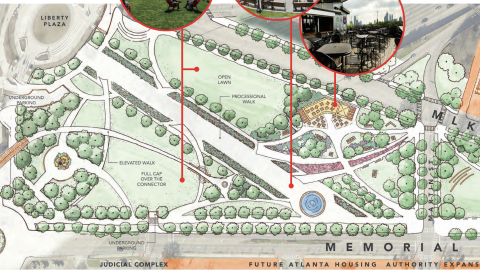
Memorial Drive Greenway project rises from dead, launches design phase
Josh Green
Wed, 08/13/2025 – 14:56
A greenspace initiative that for years appeared more buried than Oakland Cemetery residents will be dusted off and resuscitated in the near future, according to City of Atlanta officials. Plans for the Memorial Drive Greenway trace back to initial studies and land acquisitions in 2001. Fifteen years later, the 2016 Memorial Drive Vision Plan was finalized, promising a beautified linear greenspace that would complement billions of dollars in private investments flooding into the corridor during that time, largely fueled by Atlanta Beltline buzz. But then, for the most part, crickets. Today that’s changing, as the city’s Department of Parks and Recreation is officially launching a fresh Memorial Drive Greenway design phase in partnership with Pond & Company. The Peachtree Corners-based planning and landscape design firm is also behind the Beltline’s under-construction Enota Park project, large-scale pedestrian upgrades in Buckhead, and a flood-solving, 5-acre park underway in Peoplestown, among other projects.
Full scope of the finalized Greenway plan compiled in 2016. City of Atlanta Department of Parks and Recreation
The Greenway revival comes in the wake of downtown’s highway-capping Stitch project losing the bulk of its funding—more than $150 million in federal cash previously approved by President Joe Biden’s administration—that was required to complete phase one. (Stitch leadership insist the project will continue to move forward and seek alternate funding sources.) Broadly speaking, Greenway plans call for remaking half a mile of underutilized land between Oakland Cemetery and the eastern edge of downtown into an accessible, leafy linear park. The land in question totals 8 and ½ acres sandwiched by Memorial Drive (the southern border) and Martin Luther King Jr. Drive (northern border). Plans for the first phase call for gathering public input and compiling schematic designs for the full length of the park. That would be followed by finalized designs, permitting, and construction for one of seven city-owned blocks included in the Greenway’s scope, city official announced today. Absent from phase one is the “cap park” component that called for bridging greenspace over the downtown Connector, as the initial scope will focus on “achievable next steps,” per the announcement. The beginning of the collaborative process was described as a “milestone” by city officials. The 2016 vision plan will serve as a “foundational guide” for revised designs, according to project leaders. Those Greenway revisions are expected to include Sustainable Sites Initiative strategies, which call for native plantings and stormwater management in an effort to boost public health and biodiversity. Next steps call for launching a public engagement phase with project designers and other stakeholders later in August, to continue over coming months. Details and updates on that process will be posted on the city’s Parks and Recreation website. The Greenway’s design phase is being funded by $560,037 in discretionary funds from City Council District 5, as part of the Moving Atlanta Forward bond; and $500,000 from the Department of Parks and Recreation’s fiscal-year Park Improvement Fund, per city officials.Beyond city leadership and designers, partners in the project were cited as Mailchimp cofounder Dan Kurzius, The Integral Group, The Conservation Fund, Park Pride, and the Friends of Memorial Drive Greenway. “Every neighborhood deserves access to quality parks and greenspace, and I am eager to see this project through,” said Mayor Andre Dickens, in a statement regarding the Greenway. “This is what transformational infrastructure looks like: inclusive, innovative, and inspired by the people it serves,” added Atlanta City Councilmember Liliana Bakhtiari, whose District 5 includes the area in question. “From skate parks to shade trees, the Greenway is built not just for today’s Atlanta, but for the generations who will inherit it.” For a closer look at finalized 2016 Greenway plans, zoom in over here….Follow us on social media: Twitter / Facebook/and now: Instagram • Summerhill news, discussion (Urbanize Atlanta)
Tags
Memorial Drive Greenway
Pond & Company
Oakland
Oakland Cemetery
Downtown Atlanta
Memorial Drive
2016 Memorial Drive Vision Plan
Martin Luther King Jr. Drive
Downtown Connector
Sustainable Sites Initiative
The Friends of Memorial Drive Greenway
Liliana Bakhtiari
The Conservation Fund
The Integral Group
Park Pride
Dan Kurzius
Mailchimp
Atlanta Department of Parks and Recreation
Parks and Recreation
Atlanta Parks
Images
Full scope of the finalized Greenway plan compiled in 2016. City of Atlanta Department of Parks and Recreation
Subtitle
Greenspace plan compiled in 2016 to guide renewed city push for linear park
Neighborhood
Grant Park
Background Image
Image
Before/After Images
Sponsored Post
Off Read More
Memorial Drive Greenway project rises from dead, launches design phase
Josh Green
Wed, 08/13/2025 – 14:56
A greenspace initiative that for years appeared more buried than Oakland Cemetery residents will be dusted off and resuscitated in the near future, according to City of Atlanta officials. Plans for the Memorial Drive Greenway trace back to initial studies and land acquisitions in 2001. Fifteen years later, the 2016 Memorial Drive Vision Plan was finalized, promising a beautified linear greenspace that would complement billions of dollars in private investments flooding into the corridor during that time, largely fueled by Atlanta Beltline buzz. But then, for the most part, crickets. Today that’s changing, as the city’s Department of Parks and Recreation is officially launching a fresh Memorial Drive Greenway design phase in partnership with Pond & Company. The Peachtree Corners-based planning and landscape design firm is also behind the Beltline’s under-construction Enota Park project, large-scale pedestrian upgrades in Buckhead, and a flood-solving, 5-acre park underway in Peoplestown, among other projects.
Full scope of the finalized Greenway plan compiled in 2016. City of Atlanta Department of Parks and Recreation
The Greenway revival comes in the wake of downtown’s highway-capping Stitch project losing the bulk of its funding—more than $150 million in federal cash previously approved by President Joe Biden’s administration—that was required to complete phase one. (Stitch leadership insist the project will continue to move forward and seek alternate funding sources.) Broadly speaking, Greenway plans call for remaking half a mile of underutilized land between Oakland Cemetery and the eastern edge of downtown into an accessible, leafy linear park. The land in question totals 8 and ½ acres sandwiched by Memorial Drive (the southern border) and Martin Luther King Jr. Drive (northern border). Plans for the first phase call for gathering public input and compiling schematic designs for the full length of the park. That would be followed by finalized designs, permitting, and construction for one of seven city-owned blocks included in the Greenway’s scope, city official announced today. Absent from phase one is the “cap park” component that called for bridging greenspace over the downtown Connector, as the initial scope will focus on “achievable next steps,” per the announcement. The beginning of the collaborative process was described as a “milestone” by city officials. The 2016 vision plan will serve as a “foundational guide” for revised designs, according to project leaders. Those Greenway revisions are expected to include Sustainable Sites Initiative strategies, which call for native plantings and stormwater management in an effort to boost public health and biodiversity. Next steps call for launching a public engagement phase with project designers and other stakeholders later in August, to continue over coming months. Details and updates on that process will be posted on the city’s Parks and Recreation website. The Greenway’s design phase is being funded by $560,037 in discretionary funds from City Council District 5, as part of the Moving Atlanta Forward bond; and $500,000 from the Department of Parks and Recreation’s fiscal-year Park Improvement Fund, per city officials.Beyond city leadership and designers, partners in the project were cited as Mailchimp cofounder Dan Kurzius, The Integral Group, The Conservation Fund, Park Pride, and the Friends of Memorial Drive Greenway. “Every neighborhood deserves access to quality parks and greenspace, and I am eager to see this project through,” said Mayor Andre Dickens, in a statement regarding the Greenway. “This is what transformational infrastructure looks like: inclusive, innovative, and inspired by the people it serves,” added Atlanta City Councilmember Liliana Bakhtiari, whose District 5 includes the area in question. “From skate parks to shade trees, the Greenway is built not just for today’s Atlanta, but for the generations who will inherit it.” For a closer look at finalized 2016 Greenway plans, zoom in over here….Follow us on social media: Twitter / Facebook/and now: Instagram • Summerhill news, discussion (Urbanize Atlanta)
Tags
Memorial Drive Greenway
Pond & Company
Oakland
Oakland Cemetery
Downtown Atlanta
Memorial Drive
2016 Memorial Drive Vision Plan
Martin Luther King Jr. Drive
Downtown Connector
Sustainable Sites Initiative
The Friends of Memorial Drive Greenway
Liliana Bakhtiari
The Conservation Fund
The Integral Group
Park Pride
Dan Kurzius
Mailchimp
Atlanta Department of Parks and Recreation
Parks and Recreation
Atlanta Parks
Images
Full scope of the finalized Greenway plan compiled in 2016. City of Atlanta Department of Parks and Recreation
Subtitle
Greenspace plan compiled in 2016 to guide renewed city push for linear park
Neighborhood
Grant Park
Background Image
Image
Before/After Images
Sponsored Post
Off
Retail center next to Dunwoody Village sells for $7.3 million
Retail center next to Dunwoody Village sells for $7.3 million
It’s the second transaction of note this year near Dunwoody Village.
It’s the second transaction of note this year near Dunwoody Village. Read MoreBizjournals.com Feed (2022-04-02 21:43:57)
It’s the second transaction of note this year near Dunwoody Village.
Retail center next to Dunwoody Village sells for $7.3 million
Retail center next to Dunwoody Village sells for $7.3 million
It’s the second transaction of note this year near Dunwoody Village.
It’s the second transaction of note this year near Dunwoody Village. Read MoreBizjournals.com Feed (2019-09-06 17:16:48)
It’s the second transaction of note this year near Dunwoody Village.
Cities grapple with short-term rental rules as 2026 FIFA World Cup approaches
Cities grapple with short-term rental rules as 2026 FIFA World Cup approaches
As World Cup host cities prepare for an influx of visitors, some may reconsider their stance on short-term rentals.
As World Cup host cities prepare for an influx of visitors, some may reconsider their stance on short-term rentals. Read MoreBizjournals.com Feed (2022-04-02 21:43:57)
As World Cup host cities prepare for an influx of visitors, some may reconsider their stance on short-term rentals.

